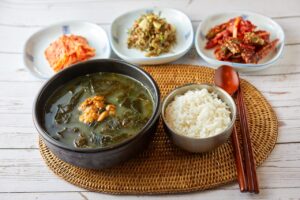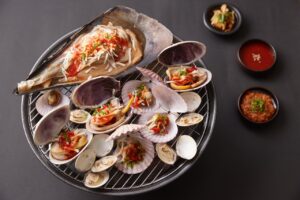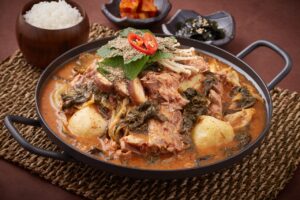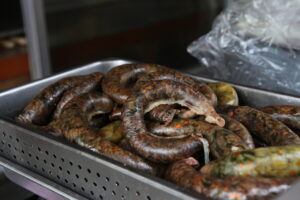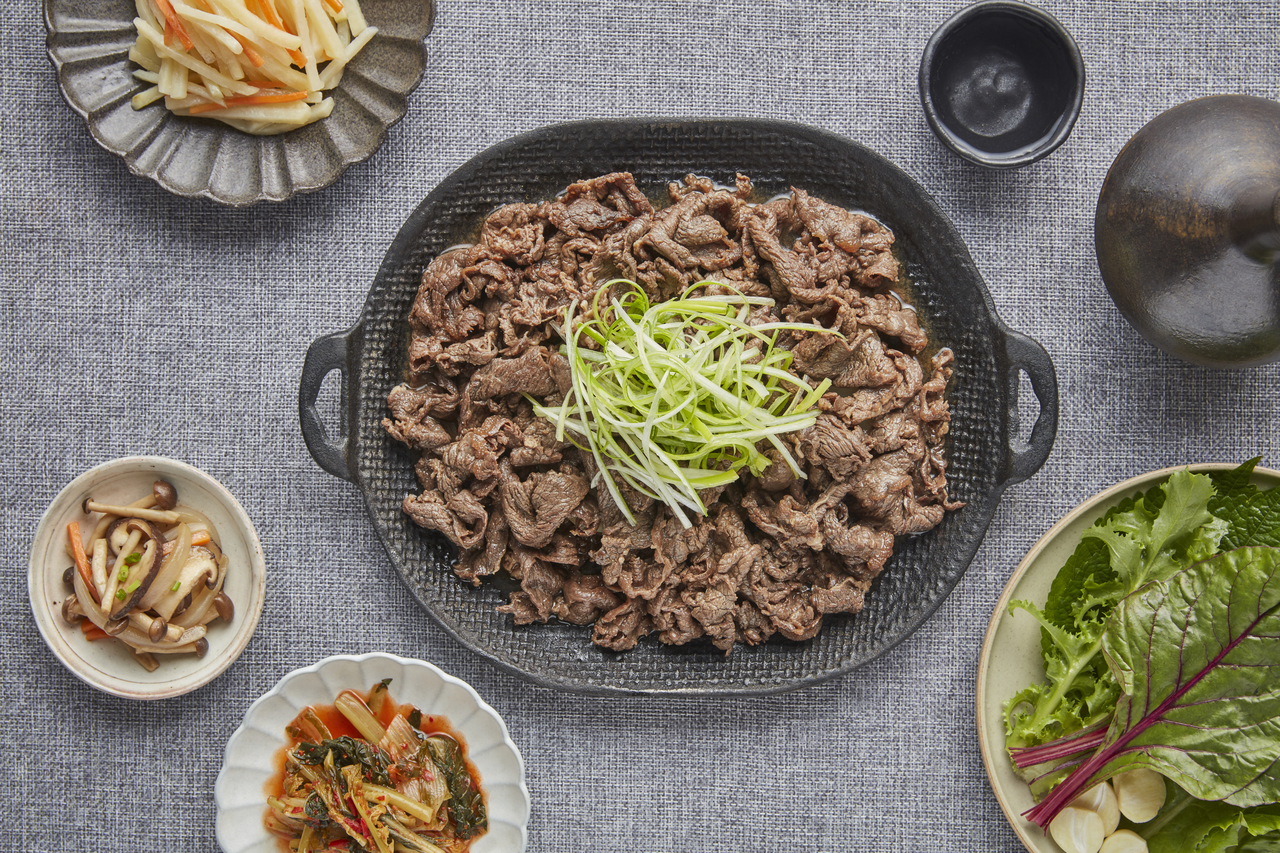
Bulgogi ⓒ한국관광공사 사진갤러리-알렉스 분도
What is Bulgogi?
Bulgogi is a classic Korean dish made of thinly sliced or marinated beef (sometimes pork or chicken) that is grilled or pan-fried. The name “Bulgogi” translates to “fire meat” in Korean, which reflects the traditional method of cooking it over an open flame. It’s a popular and well-loved dish in Korea and has gained international popularity for its delicious and unique flavor.
To prepare Bulgogi, thin slices of meat are marinated in a mixture of soy sauce, sugar, sesame oil, garlic, ginger, and other seasonings. This marinade infuses the meat with a sweet, savory, and slightly smoky flavor. The marinated meat is then cooked quickly, either on a barbecue grill, stovetop griddle, or in a pan, until it’s caramelized and tender.
It is often served with a variety of accompaniments, including rice, lettuce leaves, or perilla leaves, which can be used as wraps. It’s also common to garnish Bulgogi with sesame seeds, sliced scallions, and sometimes a dollop of gochujang (Korean red chili paste) for an extra kick of flavor.
The versatility and delightful taste of Bulgogi have made it a popular dish in Korean cuisine and a favorite in Korean barbecue restaurants worldwide. It’s a great dish for gatherings and can be customized with different meats and vegetables to suit your preferences.
History
The history of Bulgogi, a classic Korean dish, dates back several centuries and reflects the culinary evolution and cultural influences in Korea. While the exact origins are not well-documented, it has a rich history that spans many centuries. Here’s a brief overview of the history of it.
- Ancient Origins: The concept of grilling or cooking thinly sliced or marinated meat over an open flame is not unique to Korea and can be traced back to ancient traditions in many cultures. In Korea, this style of cooking, often associated with meat preparation, evolved over time to become what we now know as Bulgogi.
- Goguryeo and Three Kingdoms Period: The earliest mention of a similar dish to Bulgogi can be traced back to the Three Kingdoms period (57 BC – 668 AD) in ancient Korea. The Goguryeo people, one of the Three Kingdoms, are often credited with grilling meat, and some historians suggest that this could be an early precursor to Bulgogi.
- Mongol Influence: The Mongol invasions and occupations of Korea during the 13th century may have played a role in shaping Korean cuisine, including Bulgogi. The Mongols brought with them their own culinary traditions, which might have influenced the way meat was prepared and cooked in Korea.
- Transition to Modern : The dish that we now recognize as Bulgogi began to take its modern form during the Joseon Dynasty (1392-1910). During this time, soy sauce, garlic, and various spices and seasonings became integral to the dish’s preparation.
- Post-Korean War Era: After the Korean War (1950-1953), it gained popularity and became more accessible to the general population as South Korea underwent economic development and urbanization. Various regional variations one began to emerge, showcasing the diversity of Korean cuisine.
- International Popularity: International recognition and popularity have grown significantly, especially with the global rise of Korean cuisine. It is now a well-known and beloved Korean dish worldwide.
Today, Bulgogi is enjoyed in various forms and with a wide range of accompaniments, including lettuce and perilla leaf wraps, rice, and a variety of banchan (side dishes). It remains a symbol of Korean culinary culture and is often featured in Korean barbecue restaurants both in Korea and around the world. While the origins of Bulgogi may be somewhat murky, its evolution into a delicious and iconic Korean dish is clear.

Cooking Method at Home
Ingredients:
- 1 pound (450g) beef (preferably ribeye or sirloin), thinly sliced
- 1/4 cup soy sauce
- 2 tablespoons brown sugar or honey
- 2 tablespoons sesame oil
- 1 tablespoon rice wine or mirin (optional)
- 3-4 cloves garlic, minced
- 1 small onion, thinly sliced
- 2 green onions, chopped
- 1 tablespoon sesame seeds
- 1/2 teaspoon black pepper
- 1 tablespoon vegetable oil (for cooking)
- Optional garnish: sliced green onions and toasted sesame seeds
Instructions:
- In a bowl, combine soy sauce, brown sugar (or honey), sesame oil, rice wine (or mirin), minced garlic, chopped green onions, sesame seeds, and black pepper. Mix well until the sugar dissolves.
- Add the thinly sliced beef to the marinade and coat it thoroughly. You can use your hands to massage the marinade into the meat. Cover the bowl with plastic wrap or a lid and let it marinate for at least 30 minutes. For the best results, marinate the beef for 1 to 4 hours in the refrigerator.
- In a large skillet or pan, heat the vegetable oil over medium-high heat.
- Add the thinly sliced onions to the pan and sauté them until they become translucent.
- Add the marinated beef to the pan in a single layer, making sure not to overcrowd the pan. Cook the beef for 2-3 minutes on each side until it’s cooked through and caramelized.
- Once the beef is cooked, remove it from the pan and garnish with sliced green onions and toasted sesame seeds if desired.
- Serve the Bulgogi hot with steamed rice and some side dishes like kimchi and lettuce wraps. You can also enjoy it in a Korean-style barbecue wrap (ssam) with lettuce, rice, and other condiments.
Famous Place in Korea
Korea is home to many famous and highly regarded restaurants that serve Bulgogi, but here are a few notable places you might want to consider if you’re looking for an exceptional Bulgogi experience in South Korea:
- Mapo Jeong Daepo (마포정대포): This well-known Korean barbecue restaurant, located in Seoul’s Mapo district, is famous for its high-quality beef and delicious Bulgogi. Their Bulgogi is particularly renowned for its rich flavor and quality ingredients.
- Myeongdong Kyoja (명동교자): While Myeongdong Kyoja is mainly famous for its dumplings and noodles, their Bulgogi is also a must-try dish. The restaurant is located in the heart of Seoul’s bustling Myeongdong shopping district.
- Gogung (고궁): Gogung is a restaurant in Seoul that specializes in traditional Korean cuisine, including Bulgogi. They’re known for their commitment to preserving authentic flavors and recipes.
- Sutbul Bulgogi (숯불한상): This chain of restaurants is famous for its grilled Bulgogi, which is cooked over charcoal for a unique smoky flavor. It’s a popular choice among Bulgogi enthusiasts.
- Pimatgol (피맛골): Pimatgol is known for serving a variety of Korean dishes, and their Bulgogi is well-regarded. The restaurant has a cozy and traditional atmosphere.
- Samcheonggak (삼청각): If you’re looking for a more upscale dining experience, Samcheonggak in Seoul is a hanok (traditional Korean house) restaurant that serves Bulgogi in a beautiful traditional setting.
Please note that restaurant popularity can change over time, and new establishments are always emerging. Additionally, the best place to enjoy Bulgogi can vary based on individual taste preferences. If you’re in South Korea, consider asking locals or checking restaurant reviews to find the most current recommendations for the best Bulgogi restaurants in your area.

